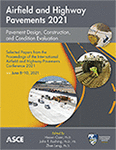Field Performance Evaluation of Pavement Sections with High Polymer-Modified Asphalt Concrete Overlays
Publication: Airfield and Highway Pavements 2021
ABSTRACT
When pavement rehabilitation becomes necessary, asphalt concrete (AC) overlays have been one of the most common treatments used by the Virginia Department of Transportation (VDOT) for maintaining or rehabilitating aged pavements. However, for composite pavements or cracked AC pavements, differential movements across any cracks or joints underlying a new AC overlay due to the combined effects of heavy wheel loads and temperature fluctuations result in physical tearing of the AC overlay. Thus, the long-term performance of many AC overlays will highly depend on their ability to resist reflective cracking from all pavement types. In 2014, VDOT initiated a research study to evaluate the effectiveness of using high polymer-modified (HP) asphalt binders in surface AC mixtures. The results were promising enough to support a field study investigating the use of HP binders in asphalt mixtures over jointed concrete pavement (JCP) as a reflective crack mitigation technique or when deemed appropriate as a tool for increased crack resistance on higher volume facilities. Since 2015, HP AC overlays have been placed at several sections over existing JCP and asphalt pavements to mitigate reflective cracking. The objective of this paper was to evaluate the viability of using HP AC mixtures as a tool to mitigate reflective cracking or when deemed appropriate as a tool for increased crack resistance on higher volume facilities. Distress survey data collected from VDOT pavement management system of HP field sections were compiled and compared alongside their control polymer modified asphalt (PMA) sections. Overall, none of the evaluated mixtures (HP or PMA) was able to totally stop reflective cracking. However, the HP sections showed the most promising performance after five years (2015–2020) from construction regardless of the traffic level and the pre-existing pavement conditions.
Get full access to this article
View all available purchase options and get full access to this chapter.
REFERENCES
Bowers, B. F., Diefenderfer, B. K., and Diefenderfer, S. D. (2018). “Evaluation of Highly Polymer-Modified Asphalt Mixtures: Phase I.” Virginia Transportation Research Council, http://www.virginiadot.org/vtrc/main/online_reports/pdf/18-r14.pdf.
Habbouche, J., Boz, I., Diefenderfer, B. K., Smith, B. C., and Adel, S. H. (2021a). “High Polymer-Modified Asphalt Binders and Mixtures: State of the Practice”, Transportation Research Record (TRR): Journal of Transportation Research Board (TRB), in-press.
Habbouche, J., Boz, I., Hajj, E. Y., and Morian, N. E. (2021b). “Influence of Aging on Rheology- and Chemistry-Based Properties of High Polymer-Modified Asphalt Binders”, International Journal of Pavement Engineering (IJPE), under-review.
Habbouche, J., Hajj, E. Y., Morian, N. E., Sebaaly, P. E., and Piratheepan, M. (2018). “Reflective Cracking Relief Interlayer for Asphalt Pavement Rehabilitation: From Development to Demonstration”, Journal of Road Materials and Pavement Design (RMPD), 18:sup4: 30-57, DOI: https://doi.org/10.1080/14680629.2017.1389080.
Habbouche, J., Hajj, E. Y., Piratheepan, M., Sebaaly, P. E., and Morian, N. E. (2019). “Field Performance and Economic Analysis of Rehabilitated Pavement Sections with Engineered Stress Relief Course Interlayers”, Transportation Research Record (TRR): Journal of Transportation Research Board (TRB), 2673(5), 351-364, https://doi.org/10.1080/14680629.2017.1389080.
Habbouche, J., Hajj, E. Y., Sebaaly, P. E., and Piratheepan, M. (2020). “A Critical Review of High Polymer-Modified Asphalt Binders and Mixtures”, International Journal of Pavement Engineering (IJPE), 21(6), 686-702, https://doi.org/10.1080/10298436.2018.1503273.
Lytton, R. I., Tsai, F. L., Lee, S. I., Luo, R., Hu, S., and Zhou, F. (2010). “Models for Predicting Reflection Cracking of Hot-Mix Asphalt Overlays.” National Cooperative Highway Research Program, Transportation Research Board, http://www.trb.org/Publications/Blurbs/163988.aspx.
McGhee, K. H. (2002). Development and Implementation of Pavement Condition Indices for the Virginia Department of Transportation, Phase I: Flexible Pavements. Virginia Department of Transportation, Materials Division.
Stantec Consulting Services Inc. and H.W. Lochner, Inc. (2007). Development of Performance Prediction Models for Virginia Department of Transportation Pavement Management System. Virginia Department of Transportation, Richmond.
Virginia Department of Transportation. (2018). State of the Pavement – 2018. Virginia Department of Transportation, Maintenance Division, Pavement Management Program.
Information & Authors
Information
Published In
Copyright
© 2021 American Society of Civil Engineers.
History
Published online: Jun 4, 2021
Authors
Metrics & Citations
Metrics
Citations
Download citation
If you have the appropriate software installed, you can download article citation data to the citation manager of your choice. Simply select your manager software from the list below and click Download.
